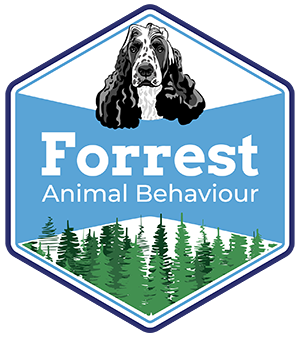Meet Saxon the Cocker Spaniel
Saxon is Cerian Forrest’s personal dog. We have included him in these case studies as he is an interesting medical and behavioural case. He is a prime example of how medical conditions can play a big role in problem behaviours.
Saxon was an 8-week-old puppy when brought into the family. From an early age, he always had a different gait with his left back leg. However, being a puppy, it was expected he would steady up on his feet once older.
Once at 6 months the gait got worse and was a big skip with his hind legs, but as non-painful it was monitored, due to his age. He also started at this point with occasional vomiting and skin problems. Yet Saxon was a very happy puppy, interested in the whole world and very outgoing in new situations, people or dogs. He was well socialized with dogs and people and was turning out a lovely little gentleman.
Then when 1 years old, he was unfortunate to experience a serious dog attack from a much larger dog on a walk. Although injuries were superficial it was quite a shock for him. What was understandable was for him to now be wary of dogs, however, what we got was much worse. Following this experience over the next coming months, even with management and support, Saxon became highly reactive towards dogs, scared of people, generalized anxiety and severe separation anxiety. All things that previously he was completely fine with and had no behavioural concerns. So, from a happy confident puppy one day, the next day we had a dog who was struggling with everyday life, worsening week by week.
Once at 14 months old was the make or breaking point for Saxon as he was struggling every day with any walks, being at home or social interactions. Therefore, we started his medical workups to rule out medical changes as his support and management was not being effective. He was diagnosed with a muscle condition in his left hind leg, which explained his gait changes. This involved x-rays and intensive physiotherapy. He was diagnosed with food allergies, which are related to his intermittent vomiting and skin problems. Once we started treatment for his leg and started managing his diet, we then continued his behavioural modification plans. This was a long road due to the number of areas we needed to address. We did it one at a time, working on dogs first, then people, then separation at home. For 18 months he was never ever left alone until we could address his separation problems.
Once at 4 years old (nearly 3 years since it all started), we had made big progress with his behaviour. However, it was never quite at the end goal or there would be occasional relapses. Due to the leg problem being ongoing and skin issues being triggered by occasional scavenging, it was believed these small areas were the causes of the plateau of progress.
Then at 5 years old (2020), Saxon had a significant eye problem requiring a medical referral. This was an acute issue, which although was life-threatening, was treated and resolved. However, they found that Saxon had sight defects that had now gotten worse, following the acute problem.
This is where it all made sense! Saxon had actually been visually impaired his whole life. Although he was not fully impaired enough to show the classic signs of sight loss (bumping into things or miss judging). He actually was struggling with fine detail, meaning social interactions were hard for him. So, from a happy puppy that knew no different, the world was a happy place even with sight problems.
But when the scary event of the dog attack happened, it shook his whole world and the bounce back reaction of multiple behaviour problems was due to his inability to cope, being visually limited.
This also tied into the fact that his progress, although much improved, never reached his full potential, as the sight affected his judgement of body language from people and dogs. Thus, he couldn’t be consistent with his reactions, as his visual feedback was so variable.
Therefore, moving forward, Saxon is going to keep losing his sight over the months/years at the age of 5 years old. However, he is a happy boy now, as we fully understand his needs. He can play and socialise with select dogs who understand him, he likes to meet new people (or choose to sit by me and watch them), he can be left at home for up to 6 hours alone and importantly he can cope with everyday life, with only relapses if any medical flare-ups.
Our next journey is to continue working and building up his confidence and consent work for veterinary treatments, which he now has to have regular checks and procedures and prepare him for full sight loss.

